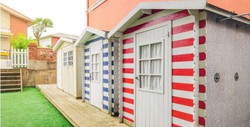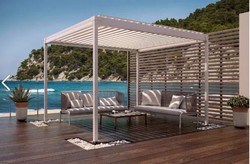Spectacular fruits in size and flavor !!
The geo textile containers made with top quality felt and nylon thread, created by hand, are eco-efficient and favor the ecological quality of the crops
They are not a pot, or a pot, or even a container, let's say it is the medium that best emulates natural conditions, without the problems of growing in a limited space, with unfavorable conditions, the container itself becomes part of the crop itself .
Who else, who least everyone has the experience of growing in pots and pots, limits the growth and development of it, due to the limited space, extreme temperatures both in summer and winter, by accumulation of all kinds of mineral salts, fertilizers, etc. and very important because we cultivate in plastic, the enemy number 1 of the roots.
Why use Feltpot felt containers ?
It is an insulating material, but it allows transpiration of the roots.
These need oxygen supply and it is very limited in the plastic containers, since it only has the upper part to ventilate the substrate. Feltpot containers allow to aerate 100% of its surface. Regardless of where you live, Feltpot pots will take care of your roots against excess temperatures, in which we recommend using our substrate covers made of the same geotextile felt.
In winter, the geotextile felt will prevent the roots of your plants from freezing and will allow them to continue breathing freely, thus avoiding the death of them, since if any branch is frozen, it can be pruned and the plant will continue to grow, but if they freeze the roots there is nothing to do. The great insulating power of the geotextile felt will save the roots from possible frosts, among others, because these containers do not accumulate water, they accumulate moisture. In summer, excess heat and contact with the soil heat the plastic, whatever the color, cooking the roots and damaging their quality, being this a focus of pests. With geo-textile pots you will prevent heat from passing to the roots of your plants, since we will remember that felt is also a material used as insulation and fully aerated, allowing heat to escape through the pores of the material in summer. The same felt traps the tips of the roots between its fibers when they reach the end of the pot, thus preventing the circular roots from developing around the container, which are very thick and spectacular, but do not absorb nutrients or irrigation water, since where the plant really absorbs is at the tip of the small roots. When the roots reach the limits of the growing medium, they are trapped by the geotextile felt, and will not continue to grow due to the detection of UV rays. That root is, throughout its entire length of feeding and as it cannot continue to grow or free itself from the felt, the plant always in its search for better conditions, has no choice but to create another root, to continue expanding, a root that will remain again trapped again and thus start again in an endless loop. The result is a substrate with millions of small, perfectly oxygenated feeder roots. Thus we will create an optimal root system for maximum absorption of nutrients. The plant will consume its resources creating beneficial roots and will not waste time making useless and endless fixing roots.
Let's say we trick the plant into thinking that it has no obstacle or limitation. We can affirm that if you grow in 11 liters in plastic, with Feltpot containers, you can plant in 8.5 liters without a doubt, since it makes better use of the substrate. The plant will spectacularly develop roots, because all the growing medium is exposed to the elements and oxygenation exceeds that of planting directly in the ground. In plastic, the result at best is a superficial layer of roots surrounding the entire container…. Those roots do not feed, they are fixing. When the root reached the limit of the plastic, it continued to grow in search of better conditions, this will create an endless fixing root that only absorbs nutrients for the last 5cm, filling the container with useless roots. From this it follows that we can use a smaller container, with its pertinent savings in every way, because the optimization of the substrate is maximum and that our plants will be stronger and more resistant to insect or fungal pests. Since the water does not remain stagnant and if the plant does not consume it, it evaporates, allowing us to interact more with the products that it needs, avoiding the blockage of the roots by excess of added products such as mineral salts, chlorine, lime or PH correctors.





Our customers trust us
Receive our news